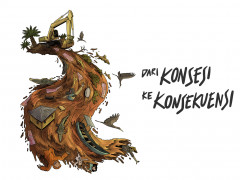State-Owned Banks Fund Companies Allegedly Damaged Peat Ecosystems
By Agiel Prakoso and Linda Rosalina (TuK Indonesia)Pantau Gambut Proposes Five Recommendations after Two Years of Peatland Restoration
Two years have passed since President Joko Widodo issued Presidential Regulation No. 1/2016, the president’s pledge to restore 2 million hectares of peatland in seven priority provinces. In a report entitled “Voices from Peatland Protection Vanguards in Seven Provinces: An Evaluation of Two Years of Peatland Restoration”, 19 NGOs from Pantau Gambut Local Networks propose five recommendations to ensure this peatland restoration target is achieved.
JAKARTA (13 February 2018)—Two years have passed since President Joko Widodo issued Presidential Regulation No. 1/2016 regarding the Peat Restoration Agency (BRG), which marks the beginning of the presidential pledge to restore 2 million hectares of degraded peatlands in seven priority provinces. The Ministry of the Environment and Forestry, BRG, the National Planning Agency, the Ministry of Agrarian Affairs and Spatial Planning and some local governments have all issued policies and conducted programs toward achieving this restoration target.
However, an independent survey conducted by 19 Non-Governmental Organizations (NGOs) in seven peatland restoration priority provinces found that there is still room to improve peatland restoration. Based on findings from the field, these 19 NGOs from Pantau Gambut Local Networks propose five recommendations to ensure peatland restoration targets are achieved, in a report entitled "Voices from Peatland Protection Vanguards in Seven Provinces: An Evaluation of Two Years of Peatland Restoration".
First, peatland restoration requires better coordination among ministries and agencies at the national and regional levels. Peatland restoration is not only BRG’s task, but also a task for the Ministry of the Environment and Forestry, the Ministry of Agriculture, provincial governments, and regional Peatland Restoration Teams.
"The lack of coordination could lead to redundant work among agencies. For example, Pantau Gambut Local Networks found that the Peatland Restoration Protection and Management Plan (RREG) that the Ministry of the Environment and Forestry is supposed to formulate has the potential to duplicate the RREG that BRG is implementing. Both plans must be coordinated to support each other; they should not be separated," explained Teguh Surya, the Executive Director of the Civil Society Foundation.
Furthermore, Yohanes Akwan, Coordinator of the Pantau Gambut Local Networks in Papua said: “The Ministry of Agriculture and local governments must synergize with the Ministry of the Environment and Forestry and BRG, particularly in enforcement of peatland restoration regulations in cultivated areas, which constitute 87% of peatland restoration priority areas.”
Second, peatland restoration requires data transparency throughout implementation to enable public participation and monitoring.
“Although Regulation No. 32/2009 on Environmental Protection and Management ensures equal rights and opportunities for communities to play an active role in environmental protection, Pantau Gambut Local Networks are having difficulty finding detailed information on peatland restoration activities. For instance, Local Networks require detailed location information for BRG interventions to verify the impact of the restoration. The Ministry of the Environment and Forestry also needs to provide public data about companies that must perform restoration and those that have submitted their Business Plan (RKU) revisions [as mandated]," said Kaoem Telapak Campaign Specialist Sarah Agustiorini.
Third, peatland restoration needs to include programs to raise awareness and strengthen the capacities of local communities in peatlands, so restoration efforts will be sustainable after 2020.
“BRG has been attempting to address this issue with the establishment of Peat Care Villages. However, Pantau Gambut Local Networks discovered that some villages that fell victim to the 2015 fires have not yet been invited to participate in the Peat Care Village program, such as Guntung Payung village in South Kalimantan. Additionally, the Peat Care Village program has not addressed important issues such as conflict resolution," said Executive Director of WALHI South Kalimantan Kisworo Dwi Cahyono.
Romesh Irawan, executive director of Kaliptra Andalas, further explained: "According to Pantau Gambut Local Networks’ interviews with local communities, restoration activities do not thoroughly involve communities. For example, well drilling activities only involved village administrators, but community members directly affected by the activities were not involved. As a result, the community doesn’t know how to use the wells, why they’re beneficial, or what tools to use with them."
Almo Pradana, Pantau Gambut project manager at WRI Indonesia added: "The capacity of the Peat Restoration Management Unit (UPRG) – consisting of the Regional Government Working Organization (OPD), business actors, and communities – should be improved, so it can develop and implement peatland restoration plans and manage peatland restoration funding in each region independently and in an integrated way."
Fourth, the supervision of concession holders’ peatland restoration activities should be strengthened. Of the total 2.4 million hectares of peatland restoration priority areas, 60% are in concession areas. According to Presidential Regulation No. 57/2016 and Ministry of the Environment and Forestry Regulation No. 14/2017, companies are required to restore peatlands degraded by corporate activities, both inside and outside their concession areas.
"However, Pantau Gambut Local Networks observed that so far the peatland restoration agenda has been more prominent in community governance areas than business concessions. For example, a concession company in South Sumatra has restored about 458,430 hectares of the total target area of 594,230 hectares. Until now, we have not received detailed data or information regarding planned follow-ups or efforts made by permit holders to restore targeted peatland areas," said Hadi Jatmiko, executive director of WALHI in South Sumatra.
Hadi recommended that concession owners' obligation to restore peatlands within their permit areas should be accelerated and enforced. This could be done, for example, by providing a clear deadline for the submission of revised RKUs and sanctioning companies that fail to comply.
Fifth, restoration activities need to accommodate local knowledge, because communities’ have proven capable of managing their territory sustainably with this knowledge. Local knowledge can be one of the benchmarks for sustainable development, ensuring peatland communities’ welfare.
"In Mantangai Hulu village, Central Kalimantan, we identified community economic activities, which have the potential to also serve as peatland restoration activities, such as fish farming, purun cultivation for handicrafts, and jelutung cultivation. These activities come from local knowledge that has been passed down for generations. It is important that peatland restoration plans consider local knowledge in each region," said Dimas Hartono, executive director of WALHI Central Kalimantan.
These recommendations are addressed to relevant government agencies, ranging from the Ministry of the Environment and Forestry, BRG, local governments in seven provinces, the Ministry of Agriculture, the National Planning Agency, and the Ministry of Agrarian Affairs and Spatial Planning. Pantau Gambut Local Networks believe that peatland restoration is a shared task, not just one organization's responsibility.
"Peatland restoration is a long journey, which cannot be completed in just five years. And it certainly cannot be the sole responsibility of one ad-hoc organization. Peatland restoration must be integrated into every ministry and institution at the national and regional levels," Almo said.
This report was prepared based on field research conducted by Pantau Gambut Local Networks at the national and local levels. The report can be downloaded for free on Pantau Gambut, a public platform to monitor peatland restoration progress. The pantaugambut.id platform also regularly monitors peatland restoration pledges; maps restoration activities undertaken by government bodies, private sector actors, and NGOs; shares stories about peatland restoration lessons learned; and provides basic information about peat.



